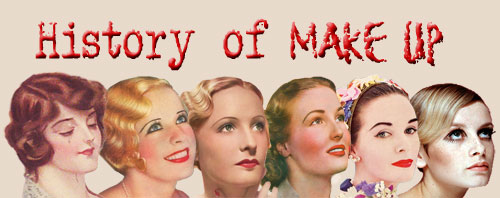Make
up has been used in various capacities over many years, playing an important
role in cultures from all around the world and also today. While it is
considered something that is used predominately be women to look pretty in
modern times, it has been presented in many other forms throughout history
including being applied to warriors before battle and aristocratic men in
Elizabethan times as a mark of sophistication. In this article, we take a look
at the history of make up and how it has impacted on the culture of the times.
It
is known that early modern humans in prehistoric times used a form of early
makeup to decorate themselves and make them stand out from each other. Whether
this was a form of beauty or tribal decoration it is not known, but as early as
10,000BC natural pigments fount in fruits, vegetables, plant extracts, castor
and olive oil was used by the people of the time to applied to their skin.
In
the early ages of Mesopotamia - around 3200BC - the first recognised cosmetic
products were produced. Later in Egypt, many items of a cosmetic nature were
used in ceremonial practises to decorate and enhance the features of the face,
as well as having decorative purposes. The use of makeup as a decorative paint
continued for many years until around 1000BC, at which point then-modern
civilisations had developed some form of everything from eyeliner and
foundation to lipstick and scented perfumes. The Roman Empire actually enforced
a 6-year ban on cosmetics during this period, after which the real make up boom
began.
It
wasn’t until the later 1500s that Queen Elizabeth I popularised the stark white
pale faces of the English court, with many people taken seriously ill as a
consequence of the toxic materials in the face powders and blushers. 200 years later,
the brightly colourful sight of Japanese Geisha maidens started to gain
popularity for their immaculately painted faces.
Cosmetics
of every form took on greater importance in society and as a way for women, and
some men to express themselves and allow them to stand out from the crowd.
American Vogue launched in 1892 to much success, and highlighted the popularity
of cosmetics and the images that brands could play out to readers. Cosmetic
brands took off in a big way with many successful companies launching around
this time. Max Factor was founded in 1904 with aims to produce cosmetics for
film actresses and models, boosting commercial sales in doing so.
It
wasn’t until after World War II that the popularity and the commercial success
and availability of cosmetics developed to the extent we know today. Cosmetic
brands launched aggressive marketing campaigns and become hugely relevant. Over
the next six decades, cosmetics took over the world and connected itself with
high fashion.
Today,
we see an ever increasing number of cosmetics brands that have stood the test
of time, allowing women and men express themselves in the most subtle or
outrageous way possible.

